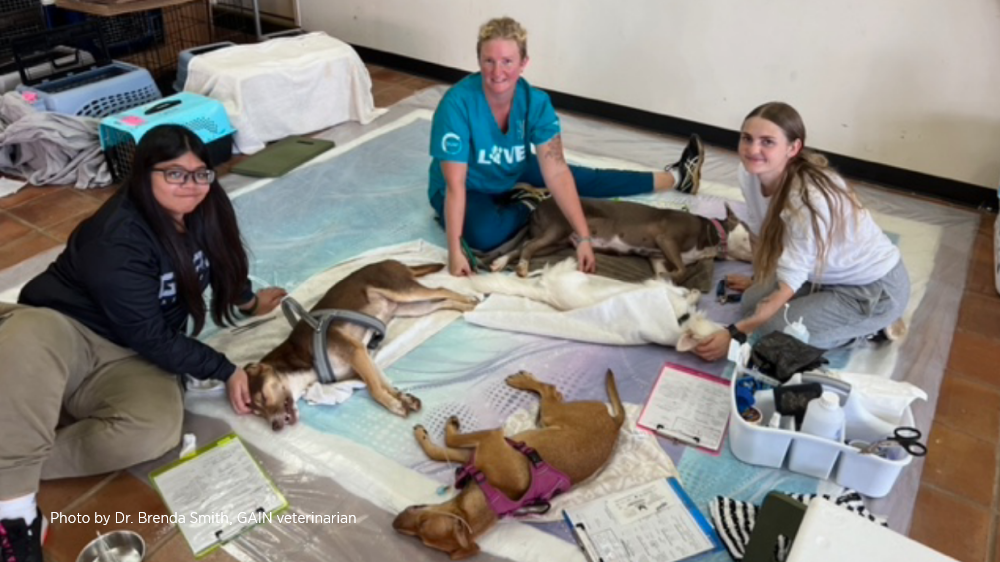
Guam animals recover from Typhoon Mawar with the support of AVMF Disaster Relief donors
The weather updates started about a week before the storm arrived. Within days, Typhoon Mawar would become a Super Typhoon. It struck the U.S. territory of Guam as a Category 4, one of the strongest storms in decades to strike the island.
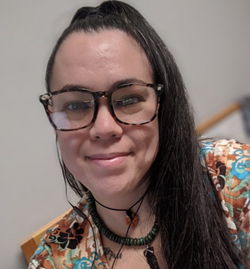 For Territory Veterinarian Dr. Mariana Quinones Turner (left), it would be her first storm as an adult. She left Guam at age 16, moving to California to prepare for college. She returned in 2021 as a veterinarian with years of experience in shelter medicine.
For Territory Veterinarian Dr. Mariana Quinones Turner (left), it would be her first storm as an adult. She left Guam at age 16, moving to California to prepare for college. She returned in 2021 as a veterinarian with years of experience in shelter medicine.
As she faced the upcoming storm, Dr. Turner’s responsibilities included more than her home and family. As the territory veterinarian, she received a call from David Rivas, a representative from the U.S. Department of Agriculture (USDA) who would help coordinate recovery efforts following the storm. He had post-storm checklists ready, and phones that would work in any emergency.
But Dr. Turner had a more pressing issue: She served Guam Animals in Need (GAIN) as a part-time veterinarian. Before the typhoon arrived, she needed to work with volunteers to find placements for all the dogs housed at the island’s only animal shelter.
“The dog runs are all outside,” she said. With Guam’s temperate climate, keeping pets available for adoption in outdoor kennels is not usually a problem. The approaching storm changed that.
Guam Animals in Need (GAIN)
GAIN is a small animal shelter located in the town of Yigo, on the northern section of the island. They take in over 5,000 pets annually from the community and animal control and manage about 54 operational kennels.
Founded in 1989, they have rescued and found homes for over 20,000 animals. In 2022, thanks in part to assistance from Dr. Turner, they re-started SNIP (Spay and Neuter Island Pets), a low-cost spay and neuter service, to help reduce the overpopulation of pets on the island.
Based on a survey conducted in 2014 by Humane Society International, Dr. Turner estimates about 60,000 to 70,000 dogs live on the 38-mile-long island of Guam; about 20,000 are free roaming.
Following the storm
Yigo was hit hard by Typhoon Mawar. According to Earth Observatory, sustained winds of 185 miles per hour made it one of the strongest May storms on record.
“Several kennels were damaged,” Dr. Turner said. “Doors ripped away, for example, along with tin roofing that provides shade.” There was some water damage as well. But the biggest problems were no electricity and no water, which lasted for five weeks. “Some people had months with no power,” she said.
Dr. Turner had experienced natural disasters in the past and was delighted by the support they received following Typhoon Mawar from a coalition of animal rescue organizations, including Greater Good Charities, the Saipan Humane Society, and the AVMF.
Non-profit coalitions
Greater Good Charities works to help people and pets by mobilizing partners and local volunteers in response to need, especially following natural disasters. The Saipan Humane Society, located in Garapan, the largest village on the island of Saipan, about 135 miles north of Guam, called on Greater Good to seek financial support for GAIN.
And Greater Good Charities turned to the American Veterinary Medical Foundation (AVMF), which provided a $10,000 grant to support recovery efforts.
The American Veterinary Medical Foundation (AVMF) is the charitable arm of the American Veterinary Medical Association (AVMA), which supports veterinarians across the nation in every specialty. Thanks to a community of donors, the AVMF offers Disaster Relief & Disbursement Grants to those providing essential veterinary medical care following devastating events.
Storm recovery efforts
Greater Good Charities planned to set up a temporary shelter to support GAIN, but the extensive damage, plus power and water issues, became huge obstacles. While volunteers were able to assist with repairs and clearing debris, they all had their own cleanup as well. Instead of needing a new location for animals, they really needed supplies.
For example, according to Dr. Brenda Smith of Saipan Humane, several families reported being unable to find pet food in the weeks following the typhoon.
“Greater Good took care of purchasing dog and cat food and they sent it over,” Dr. Turner said.
This was especially helpful since many shipments were backlogged due to the storm and recovery efforts.
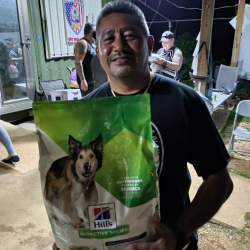 GAIN distributed the food for free to anyone who needed it. Christina Afaisen, from Yona village, was grateful for the supplies and used the food for animals in the area whose owners had evacuated before the storm.
GAIN distributed the food for free to anyone who needed it. Christina Afaisen, from Yona village, was grateful for the supplies and used the food for animals in the area whose owners had evacuated before the storm.
Food was also distributed through a nonprofit organization called “Got Your 671,” which works with veterans. Named for the 671 area code in Guam, the organization hosts twice-weekly discussion sessions for veterans and their families, as well as other activities. Most of them have dogs as support animals, and the donated food helped ease some of their financial burden.
“Anyone could come and get food for their animals,” Dr. Turner said. “People were so grateful. It was one less thing for them to worry about, and something to start to bring things back to a bit of normalcy.”
Animal rescues and SNIP
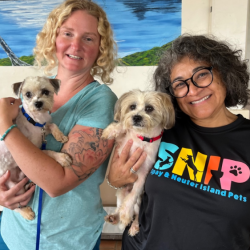 Saipan Humane also coordinated the donation of surgical supplies along with e-collars, anti-inflammatories, microchips, sedatives, and rabies vaccines. In August, three months after the typhoon, GAIN hosted a community spay and neuter clinic in the village of Inalahan, located on the southern part of the island.
Saipan Humane also coordinated the donation of surgical supplies along with e-collars, anti-inflammatories, microchips, sedatives, and rabies vaccines. In August, three months after the typhoon, GAIN hosted a community spay and neuter clinic in the village of Inalahan, located on the southern part of the island.
The clinic took place in the local mayor’s office. Dr. Smith and volunteers from GAIN helped transport several female dogs to the clinic from a local seafood restaurant in Dededo Village that regularly fed the dogs.
The three dogs were spayed, their nails trimmed, ears washed, and ticks removed in surgery recovery. Dr. Smith and another volunteer cared for the dogs at their homes during the two-week recovery period, and then returned them to the restaurant where they were being well-fed.
“Allowing the dogs to remain there will ideally prevent new, unaltered dogs from utilizing this food source,” Dr. Smith said in her report. The three dogs recovered well and seemed content to be back at their home.
Cats get care too
Steven Wolborsky, who lives near Inalahan, took a neighborhood cat to the SNIP clinic with the permission of its owner. Wolborsky had begun feeding the handsome black-and-white cat, which he nicknamed Tux, following Typhoon Mawar.
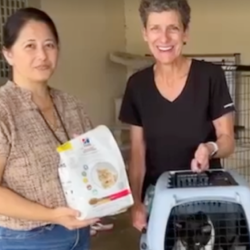 While completing the paperwork to get Tux neutered, he also checked with neighbors and discovered Tux’s owner, who had numerous dogs and cats. She was delighted to give permission for the procedure, and Wolborsky provided transportation. The clinic also supplied a bag of food for the cat following surgery. Wolborsky hopes the owner will follow-up by neutering her other animals as well.
While completing the paperwork to get Tux neutered, he also checked with neighbors and discovered Tux’s owner, who had numerous dogs and cats. She was delighted to give permission for the procedure, and Wolborsky provided transportation. The clinic also supplied a bag of food for the cat following surgery. Wolborsky hopes the owner will follow-up by neutering her other animals as well.
Dr. Turner said concluded by saying, “Receiving the AVMF disaster relief grant after weathering Typhoon Mawar has very much been a personal blessing. It’s not just about financial assistance. The compassion demonstrated by the AVMF team brings a renewed sense of hope and a chance to move from surviving to thriving. AVMF has lifted a burden that will allow me to get back to my duties as territorial veterinarian, serving the animals and people of our beautiful island of Guam.”
When disaster strikes, the AVMF supports recovery.
Responding to a disaster requires a community effort, and the AVMF helps through Disaster Relief & Disbursement Grants. The grants support members of the veterinary community affected by devastating events. Financial support helps them provide essential veterinary medical care during and following disasters.
Thanks to the generosity of donors who support the AVMF, veterinarians and volunteers who work tirelessly to help animals in times of need can count on funding to ease their worries.
Financial gifts to the AVMF ensure support for the caregivers. Together, we can help them as they aid animals, owners and communities during difficult times.